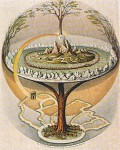by Author Jeanne Ohm, DC – ICPA.org:
It is sometimes called “our inner knowing,” “the gut feeling,” or “the wisdom within.” Whatever its name, the experience is universal. It is a feeling, a word, an image that stands out bolder than the regular stream of conscious thought and it makes a slightly deeper impression on our minds. It will continue to guide us, depending on our receptive attention to it.
Natural processes like pregnancy and birth are dependent upon a woman’s ability to trust in her inner knowing. This wisdom leads women to support and trust the process rather than work against it. In this way, nature is allowed to take its course.
For centuries, this very intuition led women in their decisions for their own health and the well being of their families. Relying on its ageless wisdom, women listened to its promptings and trusted its guidance.
During birth, women used to decide which position would be most comfortable. They were free to move about during labor and delivery to manage the pain. Somehow, they knew that the squat position allowed the pelvis to open up more freely—one-third more in fact! If other people were present at the birth, they were there to support, not direct the process. Timing was not an issue; the baby was born at just the right moment. Once born, the mother immediately held, caressed, and nursed the baby. Separation was unheard of. Mother and child recovered quickly and grew strong together. There was confidence in this process as in any other body process: with respect and a sense of fulfillment.
Today, however, the birth process has turned into a technological procedure. The medical system in the United States is considered to be the most highly advanced in the world. We spend more on birth than any other country in the world. We expect this technology to improve our lives and solve our problems. We are led to believe this technology alone leads to improved outcomes. Why then does the World Health Organization rank the United States as 24th (last) among all industrialized nations in infant mortality and low birth weight?
Doris Hare, president of the American Foundation of Maternal and Child Health says, “It compels us to ask, what proportions of these complications, which have had their onset during labor and birth, are the direct result of aggressive obstetric procedures?”
This increase in technology leads to restrictions that apparently cause more harm than good. “Women are strapped down with monitors and forced into positions which are counter to gravity and normal physiology. They are forced into the hospitals schedule, inconsiderate of their normal birthing rhythms. This greatly slows down the natural momentum. The origin of this position had nothing to do with being safer for the mom or baby and yet its practice has remained unquestioned for centuries!
These restrictions in birth make women feel afraid and powerless. Fear shuts down the process both psychologically and physically. It actually constricts blood vessels and contracts muscles. This leads to greater pain. Drugs are given to ease the pain and the woman’s physical strength and uterine function is impaired further. Her ability to stay connected with her body is impaired and even cut off. She is not told that the drugs can harm her child’s developing organs and even intelligence.
Because of drugs and maternal positions, women strain and push excessively to get the baby out. Doctors pull and twist the infant’s delicate head and spine to get the shoulders out.
Even in what is called “natural birth,” standard birthing procedures pull the head and neck. Research shows that the routine force used in birth, may injure and damage the baby’s spinal cord and nerves. One medical study published in Developmental Medicine & Child Neurology by Dr. Abraham Towbin addresses this issue even further. He says, “The birth process even under optimal controlled conditions is potentially a traumatic, crippling event for the fetus… Moreover during the last part of delivery, during the final extraction of the fetus, mechanical stress imposed by obstetrical manipulation—even the application of standard orthodox procedures—may prove intolerable to the fetus.”
Birth in our country is one of the most profound examples of how we have allowed the mystique of technology to overcome practical intuition. Before our high-tech involvement, women gave birth without outside interference. They trusted their intuition and their body’s inherent ability to function as it was created to.
It is no coincidence indeed; the very same procedures where a woman’s intuition has been violated the most— modern birthing—is also one of the greatest causes of injury to a newborn. It is also no coincidence that the health care provider who supports parents’ intuition and trust in the body’s self healing, natural processes—the chiropractor—is also the one who is most able to help reduce and correct the damaging effects of birth trauma.
Doctors of Chiropractic are seriously concerned with the amount of force being used during births. They know injury to the nervous system has a tremendous effect on a child’s ability to be healthy. This is because chiropractors work with so many children whose health has been impaired so early on in life. These birth injuries can have life-long health consequences.
One study done by Dr. Gutman, a German medical researcher, found that 80% of the newborns he examined had damage to the nerves in their necks from birth! These same children were all suffering from chronic ear and throat infections, colic, asthma, and other common childhood conditions. With specific corrections made to the misalignments in their upper necks, almost all of these children regained their health. His study, along with hundreds of case studies, shows how interferences to a child’s nervous system impair the body’s function and health.
With this research available to us, it is imperative that we as mothers become involved in our birthing decisions. We must look to decrease the possibilities of birth trauma in any way we can. Undue force and stress has become routine procedure in our modern birthing techniques. Doris Haire, former president of the International Childbirth Education Association, has investigated birthing procedures throughout the world. Her comments on births in America are not so favorable. She says, “Of all the 36 countries I have visited to observe maternity facilities, I am absolutely convinced that the United States has to be the most bizarre on earth in its management of obstetrics.”
I can remember giving a class in our community about birth trauma. When I was done, a woman in the audience raised her hand. “You are being very gracious,” she said. “I am an obstetric nurse and I have seen tremendous amounts of force used to pull out babies. One doctor resorted to putting his foot up against the table to gain greater leverage when he pulled on the baby’s neck. Than with all of his strength and weight put into it, he pulled that baby out by its head.” Most children born in modern societies with high-tech procedures have been injured at birth because of this type of unnecessary trauma to their tiny spines and delicate nervous systems.
With this evidence in hand, doctors of chiropractic are greatly concerned with routine birth procedures that lead to injury. This has led them to develop specific techniques to care for women during pregnancy. Chiropractic care throughout pregnancy removes interference to the mother’s nervous system, enhancing baby development and uterine function. It balances her pelvic muscles and ligaments and allows the baby to get into the best possible position for birth. Chiropractic care, therefore, facilitates an easier and safer birth for both mother and baby.
As mothers, it is important for us to take responsibility and make our own choices in our families’ health from conception on. Those choices need to be made from the place of inner knowing that we have, not from the fear-based approach we are taught to take. Today, it is tough for us to stand out on our inner knowing when the ways of the world are telling us otherwise. Our society does not teach us to trust the process by any means, but rather implants thoughts of fear and misgiving when the body is performing normal, natural functions.
We have been taught to fear pain, suppress symptoms, control the unscheduled timing of natural processes, and shun differences in our individual body responses. If it doesn’t fit within the norm, the average, the routine, it is not acceptable. We have been forced to restrain feelings, symptoms, and any other untimely expressions of life. We are led to look outside ourselves for solutions rather than trusting our inner wisdom.
Christine Northrup, M.D., a former obstetrician says, “I’ve learned that women and men who have a great deal of self-confidence and self-trust can go into most situations and get their needs met. One of the key ways a woman can develop a sense of trust in her own power is through birth, but most women today lack confidence in their bodies.”
Doctors of chiropractic enhance the natural process of birth and reduce birth trauma by encouraging pregnant mothers to choose safe procedures, supportive practitioners, and healthy environments for birth. They recognize that birth is a normal, natural process directed by the body’s inherent wisdom to function accordingly. They remove interference to her nervous system, optimizing this function. They offer the pregnant mother assurance and confidence in her body’s ability to accomplish this natural process. The philosophy of chiropractic and the supportive science behind it is in trusting the body’s ability to function in accordance with its own inborn intelligence.
Article originally posted at ICPA.org.





